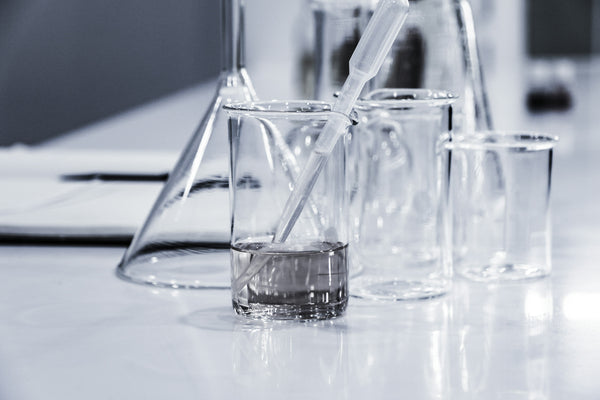Article
How EDCs Disrupt Female Fertility: Hormonal Imbalances Explained
Posted on
Endocrine-disrupting chemicals (EDCs) are synthetic or natural compounds that interfere with the body's hormonal system. For women trying to conceive, understanding how these chemicals affect hormones like oestrogen and progesterone is critical.
This article explores how EDCs impact female fertility and offers actionable steps to reduce exposure.
What Are Endocrine-Disrupting Chemicals (EDCs)?
EDCs are chemicals found in everyday products like plastics, cosmetics, and even some foods. They mimic or block hormones, causing imbalances that may reduce fertility. These chemicals are persistent in the environment and difficult to avoid entirely, making it essential to be aware of common sources.
Examples of common EDCs include:
- BPA (Bisphenol A): Found in plastics and food containers.
- Phthalates: Used in personal care products, fragrances, and plastics.
- Parabens: Preservatives found in cosmetics and pharmaceuticals.
- Pesticides: Chemicals used in agriculture that can linger on produce.
- Heavy Metals: Lead and mercury from contaminated water and certain seafoods can also act as EDCs.
Learn more about what EDCs are here.

How EDCs Affect Female Fertility
The impact of EDCs on female fertility can be profound, affecting the entire reproductive system. Here's how:
1. Hormonal Imbalances
EDCs can mimic hormones like oestrogen, leading to an excess or imbalance that disrupts ovulation. This can result in difficulties with conceiving, even for women who otherwise seem healthy.
2. Menstrual Irregularities
Research has linked high exposure to EDCs with irregular menstrual cycles. Women exposed to higher levels of BPA, phthalates, or similar chemicals are more likely to experience issues like heavy or unpredictable periods.
3. Reduced Egg Quality
Some EDCs can damage ovarian follicles, which are essential for producing healthy eggs. A decline in egg quality reduces the chances of successful conception, whether naturally or through assisted reproductive techniques like IVF.
4. Implantation and Pregnancy Loss
Disrupting hormonal balance can interfere with the implantation process, making it difficult for a fertilised egg to attach to the uterus. This imbalance can also increase the risk of miscarriage in early pregnancy.
5. Premature Ovarian Aging
Chronic exposure to EDCs can accelerate ovarian aging, reducing the reproductive window for women. Studies show that women exposed to high levels of pollutants have reduced ovarian reserves.
Although the presence of EDCs in everyday life can seem overwhelming, there are actionable steps you can take to limit exposure and support your fertility. By making intentional choices, you can reduce the impact of these chemicals on your reproductive health. Here are some practical strategies to consider:
Eat Organic Produce for Fertility Support
Choosing organic produce can reduce exposure to harmful pesticides often linked to fertility problems. Organic farming practices avoid synthetic pesticides, herbicides, and genetically modified organisms (GMOs), making organic fruits and vegetables a safer choice.
Switching to organic produce can seem daunting, but starting with a few key items can make a big difference. While it might not be practical to buy everything organic, focusing on produce that is most likely to have pesticide residue is a helpful strategy for limiting exposure.
Incorporating organic produce into your diet can be one of the simplest yet most effective ways to reduce the intake of hormone-disrupting chemicals. While not all produce needs to be organic, focusing on items most likely to carry pesticide residues can make a substantial difference in reducing your toxic load.

1. Why Organic Matters
Studies have shown that women consuming primarily organic produce have lower pesticide residues in their bodies, which can support healthier hormonal function. Pesticides such as organophosphates have been linked to reduced fertility due to their impact on hormone regulation.
2. The 'Dirty Dozen'
Each year, the Environmental Working Group (EWG) releases a list of the most pesticide-contaminated produce, known as the 'Dirty Dozen.' Consider buying these items organic to minimise chemical exposure. Examples include strawberries, spinach, and apples.
3. Wash and Peel Produce
Even when buying organic, washing produce thoroughly can help reduce any remaining pesticide residues. Peeling fruits and vegetables with thick skins, such as cucumbers or apples, adds an extra layer of protection.
Consider Fertility-Supporting Supplements
Supplements play a crucial role in supporting fertility by helping the body combat oxidative stress caused by EDC exposure. While supplements can't replace a balanced diet, targeted nutrients can enhance reproductive health.
1. Key Fertility-Supporting Supplements
- Folate: Essential for preventing neural tube defects and supporting healthy ovulation.
- Omega-3 Fatty Acids: Found in fish oil, these fats support hormone balance and reduce inflammation.
- Zinc: Vital for hormone production and egg quality improvement.
- Vitamin D: Helps regulate reproductive hormones and supports ovarian function.
- Antioxidants: Vitamins C and E can help combat oxidative stress caused by environmental toxins.
2. Choosing Quality Supplements
Opt for reputable supplement brands that are free of contaminants. For example, Zita West DHA is ultra-pure and molecularly distilled to ensure that it is free of all known contaminants, including Mercury and does not contain any Vitamin A. Look for supplements free from artificial fillers, additives, and allergens to ensure safety and effectiveness.
3. Consult a Health Professional
Before starting any supplement routine, consult with a healthcare provider, especially if you are currently undergoing fertility treatments. Personalised recommendations can optimise your supplement plan. We offer free 1:1 consultations with our inhouse nutrition team to help guide you when it comes to fertility supplements. Book yours here.
Managing EDC Exposure And Supporting Your Fertility
While EDCs are widespread in the environment, there are many practical steps you can take to limit your exposure and protect your fertility. Small, consistent changes in your daily routine can make a meaningful difference over time.
1. Focus on Small, Impactful Changes
Start with simple swaps like using glass containers, switching to natural cleaning products, and choosing organic for the most pesticide-heavy foods. These changes can have a cumulative positive effect on reproductive health.
2. Quit Smoking and Reduce Alcohol
Whilst these are not EDCs, smoking and consuming alcohol negatively impact fertility. Reducing alcohol intake and quitting smoking are great steps in preparing for conception.
3. Stress Management
As we mentioned, stress can negatively impact fertility (more on that here). While reducing EDC exposure is important, it’s equally important to avoid becoming overwhelmed by the process. Being aware of EDCs and doing what you can to limit your exposure is a step in the right direction. Managing stress through visualisations and meditation can help support your fertility journey.

It's nearly impossible to avoid all environmental toxins. Instead of striving for perfection, focus on making practical, consistent improvements. Even modest changes can support hormone balance and improve fertility potential.
Endocrine-disrupting chemicals pose a risk to female fertility by interfering with essential hormones like oestrogen and progesterone. By being aware of common sources and taking proactive steps to reduce exposure, women can better protect their reproductive health and improve their chances of conceiving. Though eliminating EDCs entirely is challenging, every small change can make a meaningful difference.
Further reading
-

Kaneka Ubiquinol (CoQ10) & Fertility: What the Research Shows
Unpacking the science behind Kaneka Ubiquinol’s role in supporting reproductive health and its antioxidant benefits for both prospective mothers and... -

Debunking Five Common Fertility Myths
Fertility is a subject that often attracts myths, speculation and outdated advice. For people who are trying to conceive, this...



